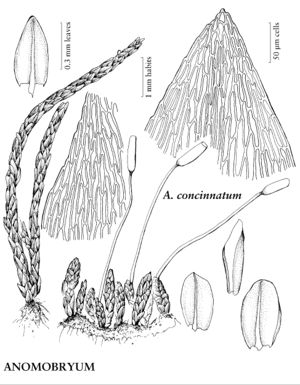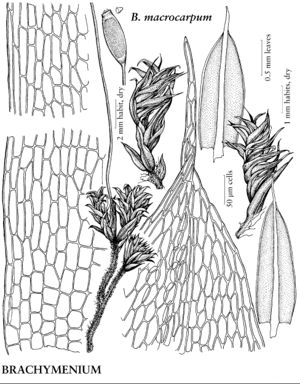Difference between revisions of "Bryaceae"
FNA>Volume Importer |
imported>Volume Importer |
||
| (One intermediate revision by the same user not shown) | |||
| Line 161: | Line 161: | ||
|publication year= | |publication year= | ||
|special status= | |special status= | ||
| − | |source xml=https:// | + | |source xml=https://bitbucket.org/aafc-mbb/fna-data-curation/src/2e0870ddd59836b60bcf96646a41e87ea5a5943a/coarse_grained_fna_xml/V28/V28_184.xml |
}}<!-- | }}<!-- | ||
-->[[Category:Treatment]] | -->[[Category:Treatment]] | ||
Latest revision as of 21:34, 5 November 2020
Plants acrocarpous, small to large, as scattered individuals or open to dense turfs or cushions, green, silver, white, golden, or red, often more than one color. Stems sometimes julaceous, unbranched to sparsely branched by subfloral innovations, stolons absent (present in Rhodobryum); rhizoids few to many, color various, smooth to papillose, micronemata and/or macronemata often present. Leaves imbricate to variously contorted or twisted when dry, erect to erect-spreading when moist, broadly lanceolate, ovate, ovate-lanceolate, obovate, or spathulate; base straight or curved at insertion, decurrent or not; margins plane, recurved, or revolute, 1- or 2-stratose, rarely multistratose, limbidium present or absent; apex broadly rounded to acute or acuminate; costa percurrent, subpercurrent, or short- to long-excurrent, apiculus sometimes present when costa ends before apex, stereid band 1, well developed or occasionally greatly reduced, guide cells present or absent, adaxial supracostal cells irregularly to regularly quadrate or short- to long-rectangular proximally; alar cells usually similar to juxtacostal cells, sometimes quadrate, region small, differentiated; laminal cells relatively uniform or obscurely to distinctly heterogeneous; proximal cells usually quadrate, short- or long-rectangular, shape often distinctly different, occasionally similar to medial and distal cells; medial cells usually similar to distal cells; distal cells short to very long, hexagonal to rhomboidal, sometimes vermicular, 2–10:1, sometimes occurring in rows oblique to costa, walls thin to thick, sometimes pitted. Specialized asexual reproduction common, of 7 distinct types: spheric to ovoid rhizoidal tubers, filiform rhizoidal or leaf axil gemmae, leaf axil bulbils, stem tubers, slender leafless terminal shoots, or leaf axil deciduous brood branchlets. Sexual condition dioicous or monoicous, sometimes polyoicous; perigonia and perichaetia terminal or lateral; perichaetial leaves same size as vegetative leaves or usually larger, sometimes forming rosette, inner leaves usually highly differentiated, often narrower, costa weaker. Seta single, sometimes multiple, color various, elongate. Capsule erect, inclined, or nutant, long-exserted, ovate, spheric, cylindric, or pyriform, occasionally zygomorphic, 1–14 mm; hypophysis well differentiated or not, sometimes inflated and rugose; exothecial cells near mouth quadrate or short-rectangular, often reddish, walls thick, in 1–3+ rows, medial cells longer, short- to long-rectangular, walls straight or sinuate; annulus usually present, revoluble; operculum convex, short- to long-conic, sometimes rostrate; peristome diplolepidous-alternate, rarely reduced to 1 layer or absent; exostome white, pale yellow, or tan, sometimes reddish, teeth triangular to lanceolate, small pores sometimes present along fissural line; endostome hyaline to pale yellow, separate or sometimes adherent to exostome, basal membrane low to high, segments narrow to wide, usually broadly perforate, cilia usually appendiculate, to variously reduced in number or length or sometimes absent. Calyptra fugacious, cucullate, small, smooth. Spores shed singly or as tetrads, rarely germinating in capsule, smooth to papillose, pale yellow, tan, or nearly hyaline, rarely darker.
Distribution
Nearly worldwide.
Discussion
Genera 15, species ca. 500 (12 genera, 93 species in the flora).
Bryaceae is a large family of acrocarpous mosses with a global distribution. Many species are adapted to disturbed soil and somewhat weedy. Species exhibit a remarkable array of specialized asexual reproductive structures, perhaps more than in any other bryophyte family. The sporophytes occasionally appear lateral due to rapid innovating growth.
Recent genetic research has radically changed understanding of relationships in the family. Studies have shown that Pohlia and related genera, traditionally considered part of Bryaceae, are more closely related to members of Mniaceae. Further, Orthodontium is only distantly related to Bryaceae, while Leptobryum appears to be closest to Meesiaceae (C. J. Cox and T. A. Hedderson 2003). Roellobryon may also be more closely related to Mniaceae; for the flora it has been removed to its own family. Within the recircumscribed Bryaceae, results based on morphology and genetics do not always agree (N. Pedersen et al. 2003). This treatment is based primarily on the morphology of the gametophyte. Differences between phylogenetic and morphological approaches are discussed under each genus.
Sizes of stems and leaves in the keys are as follows; stems: short (less than 1 cm), medium (1–3 cm), long (more than 3 cm); leaves: small (less than 1.5 mm), medium (1.5–3 mm), large (3–4 mm), robust (more than 4 mm).
Selected References
Lower Taxa
Illustrations
| Family ⠉ | Taxon | Illustrator ⠉ | |
|---|---|---|---|
 | Bryaceae | Anomobryum concinnatum | Patricia M. Eckel |
 | Bryaceae | Anomobryum julaceum | Patricia M. Eckel |
 | Bryaceae | Brachymenium macrocarpum | Patricia M. Eckel |
| ... further results | |||
Key
| 1 | Stems usually shorter than 1 cm, julaceous or sometimes gemmiform; leaves usually shorter than 1(-1.5) mm; distal laminal cells (1-)3-10:1; proximal cells quadrate or short-rectangular; specialized asexual reproduction by bulbils or absent; sexual condition dioicous | > 2 |
| 1 | Stems 0.1-6(-12) cm, rarely julaceous; leaves 0.2-10 mm; distal laminal cells usually 2-6:1; proximal cells quadrate or short- to long-rectangular; specialized asexual reproduction of all types may be present or absent; sexual condition dioicous, synoicous, autoicous, or polyoicous | > 3 |
| 2 | Plants pale green to yellow-green; stems 0.5-1.5 cm, stringlike; distal laminal cells 6-10:1, walls thick; capsules ovate-cylindric or ovate-pyriform. | Anomobryum |
| 2 | Plants white, silver-green, green, yellow-green, or brown; stems 0.2-1(-2) cm, rounded julaceous or gemmiform; distal laminal cells (1-)3-6(-8):1, walls thin to incrassate; capsules ovate or clavate. | Bryum |
| 3 | Stems rosulate; leaves ovate, obovate, or spathulate; margins usually serrate distally | > 4 |
| 3 | Stems comose, gemmiform, evenly foliate, or julaceous; leaves ovate, elliptic, oblong, spathulate, ovate-lanceolate, or triangular; margins entire to serrulate distally | > 6 |
| 4 | Stolons present; leaves 3-10 mm; costal stereid bands small or absent; specialized asexual reproduction absent. | Rhodobryum |
| 4 | Stolons absent; leaves 0.4-4.5 mm; costal stereid bands well developed; specialized asexual reproduction by rhizoidal tubers or filiform leaf axil gemmae | > 5 |
| 5 | Proximal laminal cells quadrate to short-rectangular, 1-2:1; filiform leaf axil gemmae absent; capsules erect to suberect; endostome reduced. | Brachymenium |
| 5 | Proximal laminal cells rectangular, 2-4:1; filiform leaf axil gemmae sometimes present; capsules nutant to inclined; endostome well developed. | Rosulabryum |
| 6 | Plants usually in dense cushions, pale green-silver, pinkish, or yellow-silver; leaf costal awns present, spinose, hyaline; capsules erect, oblong or cylindric; epiphytic, corticolous, saxicolous, or rarely terricolous. | Leptostomopsis |
| 6 | Plants usually not in dense cushions, green, yellow-green, red, brown, or pink; leaf costal awns present or absent, rarely spinose or hyaline; capsules inclined to nutant, if erect then short-ovoid; terricolous or saxicolous, rarely corticolous | > 7 |
| 7 | Plants green, yellow, or red; alar cells not differentiated; perigonia and perichaetia terminal; peristome double; setae rarely somewhat twisted, not geniculate | > 8 |
| 7 | Plants green, silver, pink-silver, pink-green, or red-brown; alar cells similar to juxtacostal cells or sometimes differentiated, regions small, quadrate; perigonia and perichaetia terminal or sometimes appearing lateral; peristome double, single, or absent; setae straight, flexuose, twisted, or geniculate | > 11 |
| 8 | Distal laminal cells 3-8:1; proximal cells quadrate or rectangular, shorter than distal cells; stems gemmiform or evenly foliate; leaves imbricate, not contorted when dry, if somewhat twisted then rhizoidal tubers present; limbidium absent or weak, 1-stratose; rhizoidal tubers and leaf axil bulbils common | > 9 |
| 8 | Distal laminal cells usually 2-4:1; proximal cells short- to long-rectangular, same length or longer than distal cells; stems comose to evenly foliate; leaves twisted to strongly contorted when dry; limbidium usually present, often strong, 1-or 2-stratose; rhizoidal tubers and filiform leaf axil gemmae sometimes present, bulbils absent | > 10 |
| 9 | Stems usually shorter than 1 cm, gemmiform to evenly foliate; leaves 0.4-2.5(-3) mm; leaf axil bulbils often present; capsules pyriform or ovate; hypophyses sometimes inflated and rugose. | Gemmabryum |
| 9 | Stems 0.5-3 cm, evenly foliate; leaves 1-3 mm; leaf axil bulbils absent; capsules pyriform to clavate; hypophyses slender, not inflated or rugose. | Imbribryum |
| 10 | Leaves ovate, ovate-lanceolate, or orbicular; margins entire to denticulate distally, limbidium 1- or 2-stratose; rhizoidal tubers absent, filiform leaf axil gemmae rare. | Ptychostomum |
| 10 | Leaves ovate, obovate, or spathulate; margins serrate or rarely nearly entire distally, limbidium 1-stratose; rhizoidal tubers usually present, filiform leaf axil gemmae often present. | Rosulabryum |
| 11 | Perigonia and perichaetia appearing lateral; capsules subglobose to pyriform; peristome absent or of exostome teeth only. | Haplodontium |
| 11 | Perigonia and perichaetia terminal; capsules pyriform to distinctly zygomorphic; peristome double | > 12 |
| 12 | Capsules zygomorphic; setae often geniculate; spores adherent as tetrads, at least until maturity; plants reddish brown to green or whitish to silvery green with pink tinge; specialized asexual reproduction absent. | Plagiobryum |
| 12 | Capsules not zygomorphic; setae not or rarely geniculate; spores shed singly; plants green, yellow-green, pink, or red, not silvery; specialized asexual reproduction often present | > 13 |
| 13 | Rhizoidal tubers, when present, pyriform, brown, 40-60 µm; laminal cells usually less than 16 µm wide; alar cells quadrate. | Gemmabryum |
| 13 | Rhizoidal tubers spheric, red, greater than 200 µm, or absent; laminal cells usually wider than 16 µm; alar cells usually long-rectangular. | Plagiobryoides |